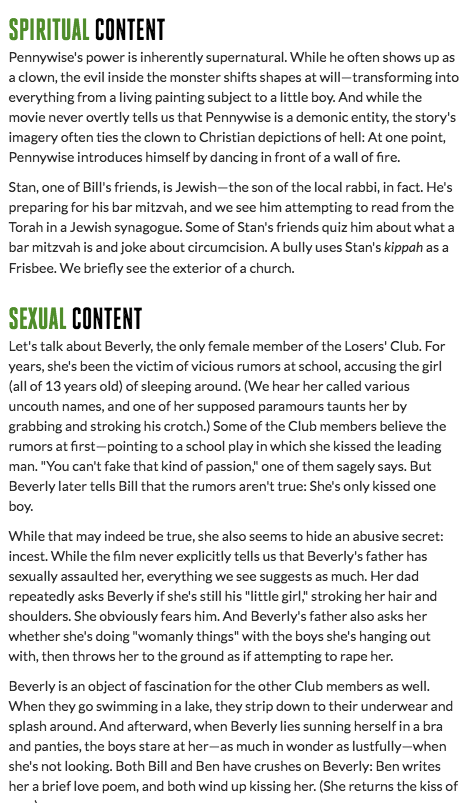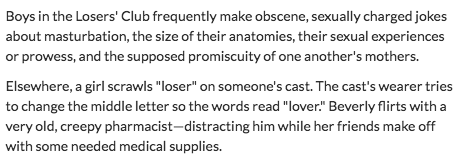Yes. Yes, we know it sounds stupid. That’s because it is stupid. Jared Moore – the former Second VP of the Southern Baptist Convention – has also claimed to find Gospel themes in Harry Potter, and wrote a “Harry Potter Bible Study,” which we wrote about back in 2013. This time, Moore took to SBC Voices to explain how, if you look close enough, you can find the Gospel in the movie and/or book about a murderous clown by Steven King.
Back in 2013 we wrote about Moore’s “talent” to find the “Gospel” in pop-culture movies and books…
If this fad is to continue, let’s face some observable realities. Although Hollywood’s mass appeal may play well in America’s churches, the truth of the matter is that it doesn’t take any serious study or introspection to turn any plot, any movie, any novel or any storyline into a biblical parallel. When churches are using last summer’s ‘Wolverine’ as a basis for a sermon series (like it was in at least one church that I know of), any plot can be stretched, molded, or eisegeted into the biblical storyline. In other words, it takes no real genius or creativity to find a comparison between any movie and a lesson found in Scripture. A pastor, for example, might turn ‘Silence of the Lambs’ into a lesson about the persecution of Christian martyrs. Maybe the 90s television series ‘Baywatch’ could be about how Jesus is the lifeguard of our soul. Or just maybe, ‘Transformers’ is about the indwelling power of the Holy Spirit to turn us into a new creature in Christ. These suggestions aren’t hyperbole. This is the extent that pastors are regularly going to in order to captivate a secular audience and give them a teachable moment of truth.
Consider the Second Vice President of the Southern Baptist Convention, Jared Moore, who is the author of the Harry Potter Bible Study. Moore turns the witchcraft-practicing Harry Potter into a Christ-figure and from it, pulls out the Gospel. I’m sure the intention is good; take an aspect of fallen, secular culture (even something as debase as a story of a child-wizard) and “find” these nuggets of Gospel truth and teachable aspects of morality. Sometimes this is referred to as “redeeming” culture. Of course, a creative person could “find” (or eisegete) similar themes in almost any story under the sun. .I’m sure most pastors could preach a rousing sermon by applying the same strategy to ‘Green Eggs and Ham.’ Somewhere in the country there will probably be a ’50 Shades of Grey’ sermon series, claiming that it parallels the Song of Solomon. You see, it doesn’t take a scholar or genius to find these supposed parallels.
But this time it’s not a wizard, it’s the story of a murdering, demonic clown that this Southern Baptist pastor is searching to find God’s truth.
Moore writes…
Where am I in this story?
If I was dropped into this world, I would be one of the outcasts, a part of the loser’s club. I think that’s King’s goal. He wants the audience to identify with the loser’s club. After all, we all feel like outcasts in this life at one point or another.
This is a world of outcasts and bullies. The outcasts are the heroes. The bullies are the bad, the evil. And there is an ultimate evil that is encouraging the bullies; “It,” Pennywise the Dancing Clown.
What’s good, true, and awesome here? Behold common grace.
A. This movie gets man’s need for community right.
1. All men, women, and children, regardless of age, need community. We need to belong. We need to be accepted.
2. And we are stronger together with people who love us than we are alone!
B. This movie gets coming of age right.
1. Most coming of age movies argue that sexual activity is what makes a person an adult. But this movie is different. Pre-marital sex is not what makes someone an adult. Puberty is not what makes someone an adult. This movie argues that what makes someone an adult is facing and overcoming your fears.
2. This movie argues that we must take responsibility for our fears. We cannot control what is outside of us, but we can control our reaction to it. We often cannot control what happens to us; but we can control how we respond to what happens to us.
C. This movie gets responding to evil right.
1. Where there is evil, it should be fought, to the death, if need be.
D. This movie gets grace right.
1. Friends giving their lives for one another should be praised! Exalting others above oneself is true love!
Moore does acknowledge that there are unwholesome aspects to this film’s cinematic presentation. He even links (to his credit) the Plugged-In Review you can see below, which demonstrates the film portrays (or story-lines) incest, sleeping around, masturbation and more troubling portrayals.
Never fear, Moore can explain how the Gospel is found in it…
How does the gospel apply?
The It creature is within us, not outside of us. We, not the world, are our greatest enemy. I see “It” in the mirror looking back at me often. Therefore, if we’re to be saved, salvation is not going to be found within us. Our friends, our community cannot save us. Every community is full of its own “It’s” as well. “It” cannot save itself from “It.” We cannot save ourselves because we are “It.”
Our salvation is found in Someone who is not a monster, but someone who was treated like a monster so that the true monsters, sinners, you and I, could go free! In the legal sense, Jesus became a monster for us, because God “made him to be sin who knew no sin, so that in him we might become the righteousness of God” (2 Cor. 5:21). Christ bore the full legal guilt for His monstrous enemies so that he could call them friends, brothers, and his Father can call them Sons and Daughters!
Reader, think of John 3:16 in light of this reality, think of God looking at His creation, looking at a world full of “It” creatures, and instead of giving us what we deserve, He sends Son to be treated like an “It” creature in our places so that we wouldn’t perish.
We often think of ourselves as innocent doves, but Jesus didn’t die for innocent doves, He died for sinners! He died for monsters! And He was treated like a monster so that we could be treated like sons and daughters of God!
And because of this reality, although I see “It” in the mirror often, I also see Christ in the mirror often. For, “I have been crucified with Christ. It is no longer I who live, but Christ who lives in me. And the life I now live in the flesh I live by faith in the Son of God, who loved me and gave himself for me” (Gal. 2:20).
We said it then (back in 2013 when Moore did this with Harry Potter) and we stand by it now…
First and foremost, we see that God used types and shadows of Biblical figures to illustrate Christ. What Moore may be overlooking is that the figures in the Old Testament were not haphazardly thrown together as a tongue-in-cheek illustration of Christ. The details of these individual’s lives and their canonization into Scripture were planned by the Holy Spirit for the explicit and expressed purpose of illustrating the coming Messiah. As weekly pointed out in my 66 Gospels sermons series, these stories of the Old Testament can’t just be used to proclaim Christ, they are designed to proclaim Christ by the inspiration of the Holy Spirit.
Secondly, we must see that God’s name and the testimony of Jesus is to be high, holy, lifted up and revered. The ultimate question must not be “is this pop culture comparison effective?” The question must be, “Does this glorify God?” There may be a time to take an example of self-sacrifice we see in the newspapers and compare it to the love of Christ displayed on the cross. The question is if we want to take fictional characters of debase or sinful circumstances and use them to typify Christ. I submit to you that we have a plethora of examples of types and shadows in stories that aren’t written by wretched mortals, but were written by the third person of the Trinity for that specific purpose. It may be one thing to quote a preacher like Spurgeon, but it’s quite another to compare Christ to Benedict Arnold or Darth Vader or some other sinister character from history or fiction.
Finally, we must view the Scripture – and the Scripture alone – as the only sufficient literary work by which we can be born again (1 Peter 1:23). I understand that not everyone wants to hear Bible stories and might be more inclined to hear about Harry Potter or The Hunger Games. But these works of fiction do not cut as sharp as any two-edged sword and they don’t divide asunder soul and spirit, joint and marrow (Hebrews 4:12). They are not guaranteed to be profitable for reproof, correction, or instruction in godliness (2 Timothy 3:16). The Bible, however, does all of these things. Why would I invent and cram a non-existent gospel theme into a work of fiction when the Bible has provided us gospel themes in the inerrant work of Scripture?
At the end of the day, jamming purported biblical themes into popular culture isn’t going to undo Christianity. This is not a primary matter of concern. But underlying the conversation is the question of scriptural sufficiency for us as evangelicals. Maybe we should start finding the gospel themes in pop culture when we run out of Bible.
[Contributed by JD Hall]













